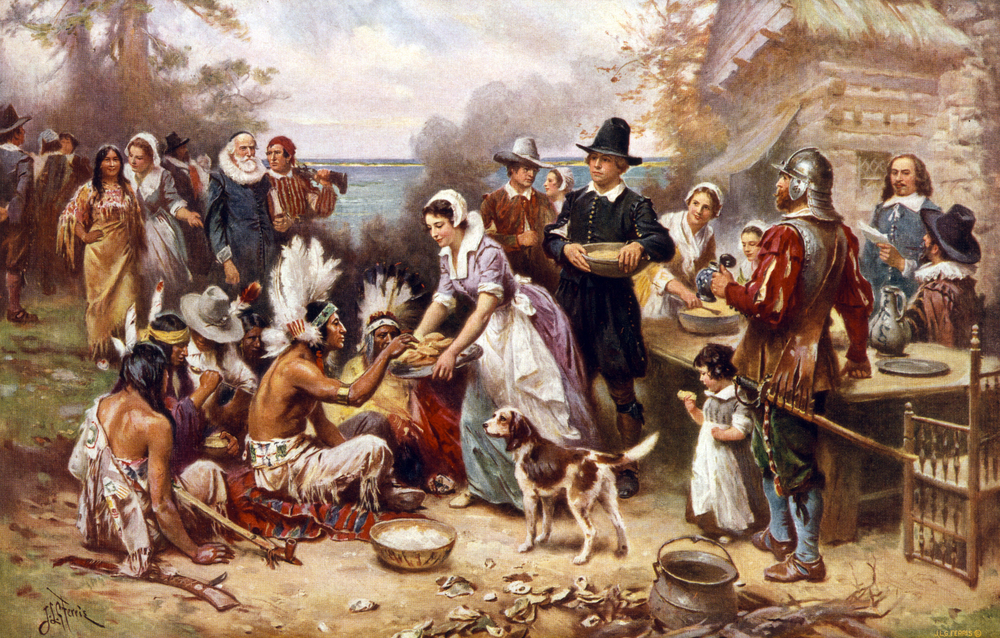I read Nathaniel Philbrick’s book Mayflower and it’s the antidote to self-pity if you need to snap out of it at Thanksgiving. We forget that when the Pilgrims celebrated Thanksgiving, what they were thankful for was just being ALIVE. I’d like to focus on different Thanksgiving story in another book, Squanto and the Miracle of Thanksgiving by Eric Metaxis. It’s a child’s book, but a story for all ages. You might want to have the book on hand for your Thanksgiving celebration, to keep the kids focused on something other than the computer. I’ve posted an article about this story before, but it’s so incredible that I never get tired of revisiting it.
Bad Timing or Providential Timing?
After putting in for repairs, the 102 passengers and 30 crew members of The Mayflower finally left Plymouth, England for America on September 16, 1620. Blown off course by storms, it wasn’t until December 17th that they dropped anchor in a harbor which they later named Plymouth Harbor. Arriving just as winter set in meant that they were unable to build adequate shelter, and 45 of them died during that first winter (a death rate of 44%). By spring there were only 57 of the original Pilgrims still alive, all of them malnourished and weak, when a native man from the Patuxet tribe called Squanto, arrived at their camp. Without his help, the survivors would not have lasted another winter. However, the story of how Squanto came to be there at just the right time to save them is a tale that is stranger than fiction. Don’t stop reading.
Squanto was born in a Patuxet village somewhere in the vicinity of present-day Plymouth, Massachusetts. In 1604, sixteen years before the Pilgrims arrived, Captain George Weymouth, who was exploring the New England coastline, captured Squanto and five members of his tribe and took them back with him to England. He taught Squanto English and trained him as an interpreter. It took ten years for Squanto to finally make his way by ship back to New England, which he did in 1614 by accompanying an expedition led by one Captain John Smith. However, just he was finally making his way back to his people at Patuxet, he was kidnapped AGAIN.
This time Squanto was kidnapped by Thomas Hunt, one of John Smith’s lieutenants, who transported him right back across the Atlantic to Spain, where Hunt tried to sell him into slavery. Some local friars discovered what Hunt was attempting, so they rescued Squanto and the other Native Americans with him. Squanto stayed with the friars for some time where he learned about their Christian faith. He eventually persuaded the friars to let him make one more attempt at the dangerous journey home to New England.
In 1619, Squanto finally returned to New England, once again aboard a ship captained by Captain John Smith! However, when at last he arrived back to his village (after being away 14 years and kidnapped twice), he discovered that during his absence, his entire tribe, as well as the majority of the coastal New England tribes, had been wiped out by a plague (possibly smallpox but it could have been measles). That is how Squanto, the last living member of his tribe, completely comfortable among Europeans and a believer in the same Christian God as the settlers, walked into the Pilgrim camp in 1620. There he found a group of people in a sorry state, greeted them in fluent English, and offered his assistance.
In addition to teaching the Pilgrims how to farm in the New World, Squanto became the translator and guide to the Pilgrims on diplomatic missions to the Wampanoag Indians who threatened the security of the settlement. Later, when he was captured by the Wampanoag, Myles Standish led a ten-man team from Plymouth to rescue the native man who was by then one of the most important members of their community. He was found alive and welcomed back by the Pilgrims at Plymouth, his adopted tribe, where he continued his vital role to the colony.
In 1622, on his way back from a meeting to repair damaged relations between the Wampanoag and Pilgrims, Squanto fell ill. Governor William Bradford recorded the details. Squanto asked the Governor to pray for him and he bequeathed some of his possessions as mementos to various friends. Bradford described the death of his friend as, “a great loss.” Thanks in large part to Squanto’s diplomatic efforts, peace between the Wampanoag and Pilgrims lasted for fifty years. (You can read the sad story of the misunderstandings that lead to war between the native tribes and the settlers in Mayflower, which only serves to emphasize what would likely have happened 50 years earlier, without the intervention of Squanto.)
That is a life story you just can’t make up. Squanto had been kidnapped twice, nearly sold into slavery, taken prisoner by another tribe, uprooted from his homeland, and lost his family and his culture. But without his uniquely difficult life, the history of the Pilgrim fathers would have been completely different. It’s a reminder that even the tragic events of life can put you in the right place, at the right time, for a great purpose.
If this is a difficult Thanksgiving for you, hang in there. You are here for a purpose.
If you want a family friendly movie to watch together at Thanksgiving, try Squanto a Warrior’s Tale, available on Amazon Prime.

Dr. Fife is a world renowned wound care physician dedicated to improving patient outcomes through quality driven care. Please visit my blog at CarolineFifeMD.com and my Youtube channel at https://www.youtube.com/c/carolinefifemd/videos
The opinions, comments, and content expressed or implied in my statements are solely my own and do not necessarily reflect the position or views of Intellicure or any of the boards on which I serve.




Thank you, Dr. Fife, for this candid and hope-inspiring account of the Providential rescue of the Pilgrims through Squanto.
Tim Mooney